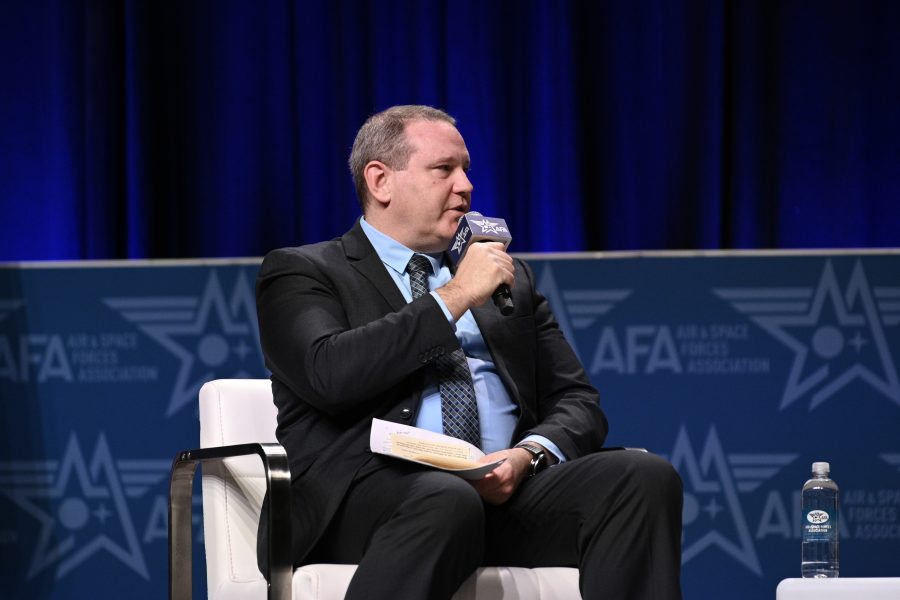Advances in artificial intelligence and software development will be key to two of the Air Force’s top programs: the DAF Battle Network, which connects sensors and shooters around the globe, and Collaborative Combat Aircraft autonomous drones, service acquisition executive Andrew Hunter said Aug. 7
Speaking at the National Defense Industrial Association’s Emerging Technologies for Defense conference, Hunter touted both programs as success stories for changes in the service’s acquisition process and areas where the Pentagon can take advantage of broad interest in the technologies.
“There’s a huge investment being made that we can capitalize on and leverage,” Hunter said. “And so we’re doing exactly that when it comes to our DAF Battle Network for command, control, communications, and battle management purposes, and also for our autonomy efforts with our Collaborative Combat Aircraft program. And we continue to leverage that.”
Hunter did not, however, mention the Next-Generation Air Dominance (NGAD) fighter that Secretary Frank Kendall recently said the Air Force was “taking a pause” on to reassess.
DAF Battle Network
During a panel discussion with undersecretary of defense for acquisition and sustainment William LaPlante, Hunter was asked how the Air Force is using new “pathways” to develop and field software outside of the traditional Pentagon acquisition process.
His first example was the DAF Battle Network, the expansive effort that encompasses the department’s Advanced Battle Management System and more, part of the Pentagon’s Combined Joint All Domain Command and Control (CJADC2) initiative.
“We’ve used the software pathway quite a bit for our DAF Battle Network, which is kind of the big picture evolution of where we’re going with ABMS program, as an enterprise capability to share information, not just within the Department of the Air Force, but also with the joint force, with allies and partners as well,” Hunter said. “So a lot of those efforts have been software pathway programs. And I think that’s been really helpful to us, it’s been effective. It’s allowed us to be more agile.”
He added that a large part of that success has been the creation of large “vendor pools with modular open systems architectures.” This has allowed the Air Force to award contracts for work on the network in chunks, boosting competition.
In July 2022, for example, the Air Force awarded 27 companies an indefinite delivery, indefinite quantity, multiple-award contract worth up to $950 million for CJADC2 capabilities. A few months later, it selected five companies to be part of its “ABMS Digital Infrastructure Consortium.”
Some of those companies are major contractors, like L3Harris, Northrop Grumman, and Raytheon. Others, however, are much smaller or less traditionally involved in defense, and Hunter said they all have a role to play.
That could prove especially important as the kinds of software the Air Force needs evolve.
“When I talk about the DAF Battle Network, you’re talking about a global operational experience—many, many thousands of things happening, essentially simultaneously,” he said. “We absolutely are going to do more and more AI to execute that successfully, even though that AI is essentially there to support human decision-makers.”
CCA
Like the DAF Battle Network, Collaborative Combat Aircraft will need artificial intelligence to automate low-level tasks and allow Airmen to focus on “higher-level interventions,” Hunter said.
The two programs are also similar in that Air Force officials have stressed the importance of competition among vendors looking to build Collaborative Combat Aircraft.
The Air Force and industry established common understandings and architectures for CCAs in particular, which help the program feel “really good and really valid” for all competitors, even those who have not yet won a contract, Hunter said.
And while General Atomics and Anduril were picked to design the first increment of CCAs, other companies are still involved in developing the software that will fly the aircraft, officials told reporters at last month’s Life Cycle Industry Days conference.
The end result, Hunter said, has been an “exemplar” of a program. That descriptor comes even as the program most closely associated with CCA—NGAD—faces an uncertain future. It appears CCA may also be leading leaders to consider changes for NGAD, as Kendall has pushed for smaller contractors to be involved in new aircraft design and technology.


